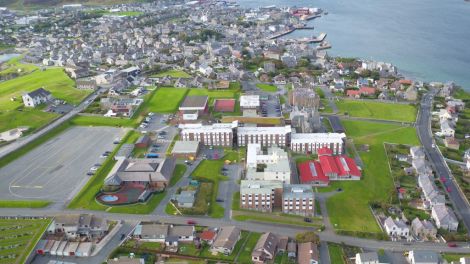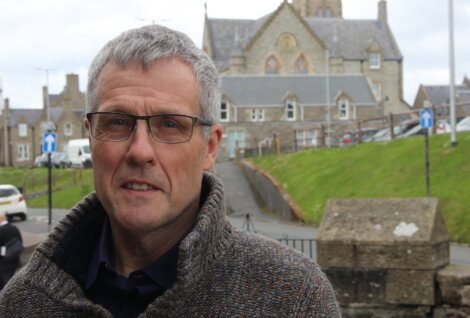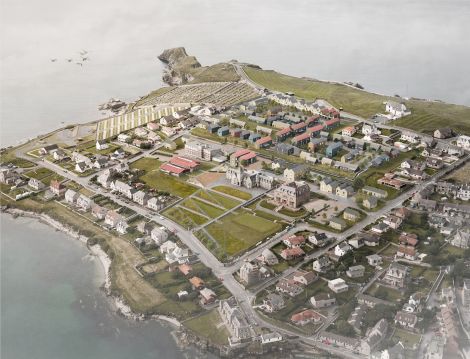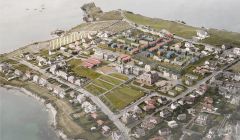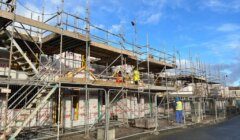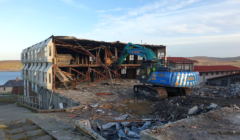Council / Demolition of old Anderson buildings edges closer
The hope is that a contract for the demolition work should be awarded soon
A LERWICK councillor has reassured local residents that officers will keep them updated on the upcoming demolition work planned at the old Anderson High School site.
Lerwick South member Dennis Leask, who chairs the council’s development committee, also said a contract for the demolition should be awarded soon.
Former pupils will have memories of sitting in classrooms, eating in the canteen, or perhaps making a home from home in one of the hostels.
But many of the site’s buildings will be demolished to pave the way for the council’s Knab redevelopment, which places new housing at its heart.
Only the listed buildings – such as the original Janet Courtney and Bruce hostels and the Anderson Institute – will remain, as well as the old science block. The latter building has been earmarked for use by the New Life Church.
According to prior notification documents lodged with Shetland Islands Council’s (SIC) planning service, the buildings have deteriorated since the school was relocated in 2017, and they represent a “considerable security risk and financial burden” to the local authority.
The proposed window for working hours is 8am to 7pm Monday to Friday and 8am to 1pm on Saturday.
“Given the residential nature of the surrounding area, a later 8am start time is proposed rather than a 7am start time, which is more typical in the construction industry,” it adds.
The documents state that nearby residents will be kept “informed in advance of any key dates, and updated on progress and any upcoming activities that are relevant to them”.
“This will be by way of newsletters, emails and local media, or door to door visits for specific issues,” they add.
Residents of the neighbouring Gressy Loan recently wrote in a collective letter that they had some “major concerns” over the wider plans for the redevelopment, particularly around parking, traffic and access.
Become a member of Shetland News
The SIC said in response that the feedback will inform the planning application for the infrastructure and public realm elements of the development.
Speaking this week, Lerwick South member Leask said: “As a local councillor, and chair of the council’s development committee, I can reassure local residents that our team will be keeping them updated on what’s planned, and will be in regular contact as the work goes forward.
“They’ll also have contact details for officers should they need to get in touch.”
He added that it is “great to see this project moving forward”.
“The redevelopment at the Knab will be an important boost for local housing, and for the wider community, and this is a major milestone in the project,” Leask said.
Meanwhile the appointed demolition contractor will be required to prepare a transport and traffic management plan for the demolition, for the consideration and approval by SIC.
However, likely routes for transporting recycling and waste materials have already been identified.
Vehicles are expected to travel down Knab Road and turn left at the roundabout before heading onto the Gremista Waste Management Facility.
The contractor would also have to prepare an environment management plan.
It is said they will use modern, efficient and silenced plant and low noise generators.
Documents also show that materials arising from the demolition works that could potentially be reused for future site development have been identified.
However, a voice in the local construction industry has raised concerns over the environmental impact of the demolition.
Stewart Douglas said in response to the prior notification submission that “against the backdrop of climate change, there is a concern that the project’s impact on the environment has not been fully considered”.
“We are in a climate crisis and the amount of carbon we emit into the atmosphere in the years to come is of paramount importance.
“The construction industry is the largest consumer of natural resources and the largest contributor to waste in Scotland,” he added.
“Fifty per cent of the whole-life carbon emissions of new buildings arise during demolition and construction activities and generates at least 50 per cent of our overall waste.”
Douglas also questioned how disposal of different material, like asbestos, timber, plastics and oils, will be dealt with, and how stockpiles of crushed stone will be managed.
The Knab redevelopment could see around 140 homes of varying sizes built in phases, while the retained buildings will have mixed uses.
One proposal is to transform the Anderson Institute into a creative hub featuring workspaces, artists’ studios and exhibition space.
Become a member of Shetland News
Shetland News is asking its many readers to consider paying for membership to get additional features and services: -
- Remove non-local ads;
- Bookmark posts to read later;
- Exclusive curated weekly newsletter;
- Hide membership messages;
- Comments open for discussion.
If you appreciate what we do and feel strongly about impartial local journalism, then please become a member of Shetland News by either making a single payment, or setting up a monthly, quarterly or yearly subscription.
















